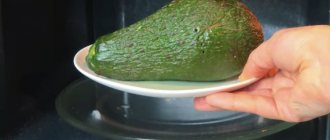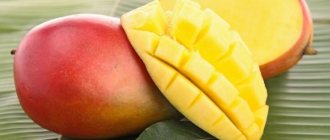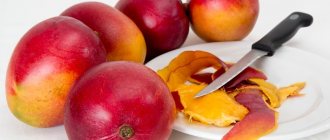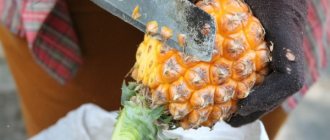Features of Green Mango
Mango fruits come in a variety of varieties, so there are ripe fruits that are green on top.
Useful properties of the fruit:
- prevention of colds due to the presence of a large amount of vitamin C;
- improved vision is ensured by the presence of vitamin A;
- normalization of the nervous system due to the presence of vitamin B6;
- stabilization of the digestive system;
- removing toxins and waste from the body;
- lowering cholesterol and blood sugar levels, so the fruit can be consumed for diabetes and for weight loss;
- prevention of the development of cardiovascular diseases due to the maximum potassium content;
- positive effect on bone tissue and rapid healing of skin lesions;
- prevention of the development of oncological processes in the body;
- acceleration of metabolism, removal of excess fluid from the body.
The calorie content of green mango per 100 grams of product is only 67 calories.
Before directly consuming the fruit, it is important to consider some contraindications for its use:
- use for children under 3 years of age;
- avoiding alcohol consumption in combination with mangoes;
- predisposition to allergies;
- increased sensitivity of mucous membranes.
Useful tips
When purchasing mangoes and their subsequent storage, experts recommend that buyers use some tips.
- To accurately determine whether a fruit is ripe or not yet, you need to focus on the degree of hardness of the fruit, as well as the color of its skin.
- If you bought an unripe mango, do not put it in the refrigerator. Under the influence of low temperatures, the fruit will definitely not ripen. Moreover, prolonged exposure to cold will only spoil the product. But overripe fruit is best stored in the refrigerator.
- Storing ripe fruit for too long is not allowed. The optimal storage time for whole or chopped ripe mango is no longer than 5 days. You can keep the fruit in the freezer for about 6 months.
- If you have chosen the method of ripening the fruit using a paper bag, you can improve it by adding a regular apple to the bag. This will significantly speed up the process.
- In general, you can safely buy a fruit when its peel has a bright color and good density, and also provided that a pleasant aroma emanates from the fruit.
- When determining the degree of ripeness of a fruit and its taste, you should not rely only on smell or color. Approach this issue comprehensively.
Use the listed rules and tips, and you can easily ripen mangoes at home and enjoy the magnificent exotic taste.
To learn how to cut a mango, watch the following video.
Storing ripe fruit
It is advisable not to store fresh mangoes for a long time, but to eat them immediately. This way you will feel the maximum taste and tropical pleasure.
Signs of a ripe mango
As mentioned above, several parameters are responsible for the ripeness of a mango:
- The mango should have a glossy, dense and elastic surface without damage.
- The smell should be distinct, but not strong.
- The shape of the mango must be round, otherwise the fruit is not ripe.
Storing cut mango
The cut fruit has a very short shelf life. The pulp turns black, hardens and loses its taste. It is recommended to store this way only in an airtight container, and no more than a day.
Optimal storage conditions
If there is a need to preserve the fruit longer, then there are several options on how to do this. Mangoes can be stored indoors, in a cool, dark place, in the refrigerator and freezer.
- Mango should be stored at room temperature for no more than 5 days, after which it begins to turn black, the flesh becomes soft, and the taste becomes soapy.
- In a cool, dark place, the freshness of the mango will increase, but not much. The number of days depends proportionally on the ripeness of the fruit. The riper it is, the faster it will spoil.
- Storage in the refrigerator is optimal. On the middle shelf of the refrigerator, wrapped in paper or in a container, mangoes will keep for more than 10 days. The temperature should not be lower than +3-+5 degrees.
- In the freezer, mangoes amazingly retain all their flavor and aroma, so this is the best option for long-term storage. The freezer temperature should be from -24 to -18 degrees, so mangoes can be stored for more than 3 months.
Determining the degree of ripeness and proper storage
In order not to later wonder how to make a mango ripe, it is better to be able to determine the degree of ripeness of the fruit even when purchasing . It is not difficult:
- The ripe fruit exudes a bright, sweetish-resinous, fruity odor , especially in the area of the stalk.
- When pressed, the flesh springs slightly , like a ripe peach.
- The skin of the ripe fruit is shiny, smooth and dense , the color varies from yellow to red-orange depending on the variety. There are varieties of green mango with orange flesh, but they are extremely rare on our shelves.
- Dark spots on the surface of the fruit do not always indicate that the product has begun to deteriorate . The fruit probably contains a lot of sucrose. However, if the spots are soft and can be easily pressed with a fingernail, it is better not to buy the fruit.
- The most delicious and aromatic fruits have a spherical shape.
The ripe fruit smells of both pineapple and peach with a light trail of pine needles . Connoisseurs of this exotic fruit are sure that the strong aroma indicates one hundred percent ripeness.
Storage rules:
- Do not put green fruits in the refrigerator - the ripening process in such conditions will slow down and the product will spoil. Keep ripe and overripe fruits in the crisper drawer in the refrigerator compartment.
- The shelf life of ripe fruit in the refrigerator is 5-6 days at a temperature of +2...+5°C, in the freezer - six months at –18°C. When frozen, the product retains its taste.
- Cut fruit quickly deteriorates, the flesh darkens and loses its taste . Store this product in a food container with an airtight lid for no more than 24 hours.
- Unripe mangoes can be stored for up to 7 weeks at a temperature of +7...+9°C and air humidity of 90%.
How to peel a mango
Should mangoes be peeled before eating? Before eating the fruit, remove the skin and seeds, after which it is suitable for consumption.
How to remove a pit
There are several methods for removing seeds from fruit:
- First way. To do this, the product is placed on a cutting board and secured by hand. There should be a part with a tail on top. After this, you need to draw a knife along barely visible lines that go from top to bottom. This is done on each side. Thanks to this technique, it will be possible to facilitate the process of removing the stone and minimize the risk of damage to the fetus. The pit is easily removed with a spoon.
- Second way. In this case, the fruit will remain almost intact. Using a sharp knife, cut the fruit lengthwise. Moreover, the size of the hole should be small - no larger than the core. Place a knife into the resulting slot and carefully turn it so that the halves move apart. Then take out the bone with a spoon. This method will give good results if the mango is ripe enough.
- Third way. In this case, you can cut through the entire fruit so that the hole is along the flat part of the stone. To do this, use a sharp knife. The core is removed with a spoon.
How to peel
To peel a mango, use the following methods:
- Kitchen knife. In this case, the fruit is peeled like potatoes. To do this, cut off the thin peel. You can make 2 cuts. They are made on the other side of the ponytail. After that, it is recommended to stretch the skin with your fingers to the second end.
- Vegetable peeler. This method will take more time. However, the skin will be cut thinly and neatly.
- Without using a knife. This method can only be used for ripe fruit that has been cut into 2 parts. To do this, arm yourself with a glass. Take half the fruit in one hand and the glass in the other. Place the mango, peel side up, and gently press onto the glass. The size of the glass should be slightly smaller than the fruit. Due to this, the pulp will fall into the glass, and the skin will remain in your hand.
Diseases and pests - ways to combat them
Like all fruit crops, the mango tree is susceptible to various diseases. The plant is also attacked by pests.
Anthracnose
The fungus affects only the above-ground part of the crop. A distinctive feature is its rapid spread, which occurs with the help of wind, insects, dew and rain.
Most often, trees that have wounds or damage become sick. Because it is through them that the infection penetrates.
Signs:
- Whitish spots appear on the leaf blades. Sometimes they are brown.
- The spots are framed by a dark rim. They gradually grow in different directions and after a while merge.
- With high humidity, the disease manifests itself in the form of cracks in the stems, which soon rot. As a result, the plant dies completely.
- In dry climates, the lesion destroys the mango much faster. Diseased stems break in low winds.
Affected branches and leaves are immediately removed and burned. Cumulus DF will help cope with the disease.
Bacteriosis
Characterized by darkening of the edges of the foliage. The surface becomes wrinkled. As a result, the leaf turns black, but still adheres to the branches.
Prevention and control:
- before planting, the seed is kept in Agata-25K solution for a quarter of an hour;
- the affected parts are cut off, and 5 centimeters of healthy-looking tissue are also removed;
- the cut is coated with copper sulfate;
- Trichodermin granules are added to the soil.
Powdery mildew
A gray-white coating on the leaves that resembles flour is a sign of powdery mildew. Over time, it becomes darker and a cloudy liquid begins to ooze from the tissue. Foliage is usually affected, but the disease can also spread to fruits. As a result, they will crack and rot.
Prevention:
- spray the tree with fungicides twice a month; diluted wood ash is also suitable;
- for treatment they are treated with Topaz.
Spider mite
The insect weaves thin threads around the tops of the shoots, on which beige dots appear over time. Over time, the affected areas lose color and dry out. Daily spraying with clean water will help save the plant. This method works when pests first appear, when they have not yet had time to reproduce. The acaricide "Neoron" is used for treatment. You will have to process it three times a month.
Shchitovka
Shoots and foliage are covered with oval growths of a brown hue. Insects are smeared with kerosene and removed by hand. For prevention, it is recommended to wipe the plant every week with a cloth soaked in vodka and spray it with garlic infusion.
Aphid
Green-yellow insects settle on the tops of young leaves, shoots and buds. The pest drinks the sap of the plant. As a result, the affected areas become yellow, dry out and fall off. With small numbers of aphids, pests can be controlled manually. Just press them with your fingers. In case of mass attack, they are fought with the help of general insecticides.
Thrips
A pattern in the form of silvery strokes appears on the leaves. Small black sticks are visible on the surface - these are pests, which the drug "Tanrek" will help get rid of. If you follow all the recommendations, you will be able to grow a strong tree yourself and soon get a harvest.
Storing ripe mango
If the mango is already ripe, but you don’t want to eat it or use it for cooking, pay attention to its proper storage, which will help keep the fruit juicy and fresh longer.
There is no need to wash the fruit - this way it will be stored longer. Place the fruit in a paper bag or wrap it several times in parchment paper, and then put it on the bottom shelf of the refrigerator closer to the freezer - a lower temperature will increase shelf life. It is not recommended to leave fruit in the refrigerator door, since there it can begin to deteriorate faster due to unstable temperature conditions.
Make sure that there are no other strong-smelling foods near the mango (such as smoked fish) that it might pick up.
Check the fruit daily for softness so that it does not become too soft and crumbly, since overripe fruit can spoil in just a couple of days. Otherwise, you can store it in the refrigerator for up to 8-10 days.
We also invite you to watch a video that explains how to store mangoes:
How and how long can you store
There are several ways to store mangoes, each with a different duration.
At room temperature
Room temperature varies from +15 to +25 degrees Celsius. Under such conditions, ripe mangoes are stored for up to three days. Fruits must be placed in a dark place. To prevent them from touching each other, you should first wrap each of them with parchment paper - this will also allow you to absorb all excess moisture.
Mangoes can be stored in the pantry for up to five days at +12 degrees.
In a refrigerator
Mangoes will keep in the refrigerator for up to one week. To do this, fruit in a paper bag must be placed on the middle shelf. You can increase the storage period to ten days by placing fruits wrapped in parchment paper in a special niche with enhanced ventilation.
In the freezer
In the freezer, mango will retain its properties longer. For this, it is recommended to use small portions of fruit.
The operating principle is as follows:
- Peel the mango and then grate or cut into small pieces of approximately the same size.
- Pour in sugar syrup.
- Place in a food container.
At temperatures from -18 to -24 degrees, the fruit can be stored for up to three months.
Storage errors
Premature spoilage of mangoes is associated with the following in storage:
- Storing ripe mangoes with other fruits. They secrete special enzymes that can only accelerate ripening and reduce the shelf life of the fruit.
- Storing unripe mangoes in the refrigerator. By stopping the ripening process, you will not increase the shelf life of the fruit. This way it will spoil without even reaching a mature state.
Storage in a plastic bag. Replace it with parchment paper to prevent the fruit from rotting.
Storing pitted. If possible, leave the kernel in the fruit so it will last longer.
By following all the rules and recommendations for mango storage, you can not only avoid its premature spoilage, but also preserve all the valuable properties present in the fruit.
Storage at room temperature
You can store mangoes at home to prevent them from spoiling without refrigeration.
The fruit will retain its presentation, taste and nutritional elements for five days. Storage temperature should not exceed 10 degrees, otherwise the fruit will begin to deteriorate. It is important to know!
Mangoes can be stored indoors if the fruit has been heat-treated.
Methods of heat treatment of tropical fruit:
- confiture, jam;
- slices boiled in sugar syrup;
- marshmallows, marmalade, candied fruits;
- drying.
Mangoes are in the tropics, like apples in Russia, so the product can easily be canned, and recipes for mango preparations are similar to recipes for preparations from fruits that are familiar to us.
Exotic mango jam recipe
Mango jam is cooked if the fruit is already overripe or not yet ripe. Otherwise, it is better to eat the product fresh to get the maximum vitamins.
Ingredients:
- 1 kilogram of mango;
- 700 grams of sugar;
- juice of one lemon.
Cooking method
The fruits must be washed, dried, peeled and pitted. The fruit is cut into medium pieces, covered with sugar and placed in a basin for 5-6 hours so that the fruit releases its juice.
After the fruits have released a sufficient amount of juice, the bowl with the exotic fruit is placed on the fire and brought to a boil. Boil the mixture for 5-7 minutes, add lemon juice, pour into clean jars and roll up.
The jam according to this recipe will be liquid. If you want to make thick jam, then the mango needs to be boiled for 20 minutes over low heat. Without pasteurization, mango retains its quality for 6 months.
Drying in an electric dryer
Dried mango is used in muesli or as a snack.
Drying steps:
- the fruit is washed, dried, cut into slices 5 mm thick;
- the dryer tray is filled in one layer;
- To check the readiness of the dish, tear the slice in half; if no juice comes out when pressed, it means the fruit is dried correctly.
How to distinguish a ripe mango from an unripe one
The smell of a ripe mango has a characteristic fruity aroma, while an unripe fruit does not have any odor. Alcoholic fermentation occurs in fruits that are overripe and begin to deteriorate.
The mango should be moderately soft to the touch, since a hard peel indicates that the fruit is unripe. The ripe fruit has a round, smooth surface with characteristic brown spots.
A hard and strong peel indicates that the fruit is unripe, while damage and cracks on the surface, on the contrary, indicate that the fruit is too ripe. Therefore, when choosing a ripe mango, you need to pay attention to these aspects.
Currently reading: Dried mango: benefits and features of use
Why did the mango not ripen, but spoiled?
This happens rarely, but there are several reasons that provoke damage:
- There were “open wounds” on the skin - cuts, tears. They could contain pathogenic bacteria or fungi.
- The fruit began to rot even before being placed for ripening (as a result of a fall or blow, the flesh was injured, although the skin remained intact).
- Storage occurred at too low temperatures.
Will a mango ripen if you put it in the refrigerator? No, at low temperatures (usually 6–7°C in the main chamber) the fruit will begin to deteriorate faster than it ripens. All tropical fruits love warmth, and in order for them to ripen, it is better to store them in a dry, dark, well-ventilated place - for example, in a kitchen cabinet.
How to “finish” a cut mango? If you cut the fruit and only then discover that it is not ready to serve, use it to prepare sauces or other dishes. It will no longer be possible to bring it to ripeness - upon contact with air, the pulp quickly darkens and putrefactive processes are activated in it.
We bought a lot of unripe mangoes on sale. How to store them so that they are ripened one at a time, and not all at the same time? At home, it is difficult to ensure proper storage of these fruits. The best thing to do is to wrap each fruit in a paper towel and then arrange the mangoes so that they are not touching each other. To ripen, use the methods described above - every day or every other day, put one or two mangoes in a bag of apples (a pot of rice).
When bringing mangoes to ripeness at home, the main thing is to follow the process and not allow the fruit to become overripe or spoiled, because overripe fruits become too sugary, and rotten ones are no good for anything - they have to be thrown in the trash.
Methods for ripening the fetus at home
If you accidentally bought an unripe hard fruit, do not be upset. It can be matured at home. Ripening under normal conditions can take up to a week, but this process can be significantly accelerated.
In paper
If you wrap a mango in newspaper, parchment or a paper bag and leave it at room temperature overnight, there is a chance that the fruit will ripen by morning. This happens due to the fact that under such conditions the release of ethylene is accelerated, which affects the ripening process.
You don't need to wrap the mango too tightly. Air must penetrate under the layer of paper. Otherwise, a fungus may develop, triggering the rotting process.
Ripening in a paper bag.
In rice
This method is rooted in the centuries-old history of India. If you place unripe fruit in rice, ripening will occur much faster. This also happens due to the release of ethylene. It is important to ensure that the rice is fresh and dry. The ingress of moisture, even in small quantities, can lead to product spoilage.
Do not forget to check the condition of the mango every 6 hours, because... under these conditions, there is a risk of rapid overripening of the fetus.
Ripening in rice.
In a dark place
If you put the mango in a dark place, the ripening process will take place in a shorter time than in the light. A closet or drawer that is rarely used during the day is suitable for this purpose. It is important that there are no products or other substances with a strong odor inside, because the mango can absorb it.
Harvesting Rules
To keep tomatoes at home for a long time, certain rules must be followed when harvesting. Pick tomatoes from the garden regularly: at least once every 5 days at moderate air temperatures and once every 2-3 days during hot weather.
Both ripe and green specimens are plucked from the bush carefully to prevent the slightest damage. It is best to harvest the fruits in the morning before they get hot in the sun. The surface must be dry, so do not pick tomatoes immediately after rain.
A sharp drop in temperature harms the fruits and accelerates their rotting. If the temperature at night drops to +5 ℃, then it’s time to collect all the green tomatoes and transfer them to home storage. For greenhouse tomatoes, the permissible temperature limit is slightly higher and is +9 ℃.
You can learn how to store ripe tomatoes by reading this article on our website.
Before removing unripe tomatoes from the bush, you need to decide what to do next: speed up ripening or keep them green at least until winter.
To begin with, the tomatoes need to be sorted, selecting the browned specimens that will ripen faster than the rest. Tomatoes are laid separately at the stage of milky ripeness, ripening a little longer than brown ones. Completely green fruits can be preserved until winter and served fresh and tasty on the New Year's table.
The speed of ripening depends on the temperature in the room. At a temperature of +8…12 ℃, tomatoes turn red slowly, while an indicator of +18…21 ℃ significantly speeds up the process. The higher the temperature, the faster the crop will ripen, but the quality of the fruit may deteriorate as it ripens.
This is due to a sharp loss of moisture and, accordingly, the density of the fleshy vegetable. A temperature of about +20 ℃ is suitable exclusively for tomatoes of blanzhe (brown) ripeness, which will take no more than a week to ripen. They can be placed on the windowsill, where they quickly turn red without compromising their appearance or taste.
The optimal temperature for storing green tomatoes is considered to be from +13 to +15 ℃ with a humidity level of 80%.
There is an opinion that for better ripening, picked fruits must be placed in direct sunlight. This approach will not only not give the desired result, but will also speed up the spoilage of tomatoes.
It is recommended to store unripe tomatoes in a dark, dry place.
Rules for storing mangoes
Mangoes do not store well at home. It is recommended to eat the fruit within 2 days from the date of purchase. Otherwise, its taste and nutritional properties may deteriorate.
In a refrigerator
It makes sense to store only ripe fruits in the refrigerator. If the fruit is not yet fully ripe, it should be left at room temperature. It is worth considering that the plant is tropical and is accustomed to high temperatures.
Storing fruit in the refrigerator.
Cut fruit
Peeled and cut mangoes can only be kept in the refrigerator. It is better to eat it immediately, maximum during the day. After a day, the process of decay begins, which is fraught with poisoning.
Sliced fruit should be eaten during the day and kept refrigerated.
Features of storing exotic fruit
Mango is one of the most popular plants in India and some other Asian countries. Its fruits have a distinct sweet taste. The yellow or orange pulp with a fibrous structure is hidden under a red, yellow or greenish skin. This exotic fruit is rich in vitamins, minerals, plant fiber, proteins, fats and carbohydrates. Therefore, it is widely used for therapeutic and prophylactic purposes. In order to fully preserve the taste and healing properties, it is necessary to store mangoes in the proper way.
There are three storage options for this fruit, which should be chosen based on its condition:
- at room temperature;
- in the refrigerator, pantry or cellar;
- in the freezer.
Fresh ripe mango fruits can be reliably stored for up to one week, provided that the temperature is maintained within +3-5 °C. During the entire storage period, fruit stocks should be regularly inspected for spoilage.
It is extremely undesirable to store overripe specimens, since even if they are in the refrigerator, they quickly darken and lose their properties. Unripe fruits should not be placed in the refrigerator, since even if they ripen, they will not be able to acquire their characteristic sweet taste.
How mangoes ripen at home
Where to put mangoes to ripen? If you bought a fruit that is obviously unripe, leave it at room temperature on a tray next to bananas or apples . After 3-4 days it will “reach” and become soft.
Several simple methods using newspaper or baking paper and cereal will help speed up ripening.
Wrapping in paper
If you bought a green mango, how to make the fruit ripen? Paper will help to ripen mangoes quickly. Wrap it in regular newspaper or baking parchment and place the package in a dark place at room temperature. After 24-48 hours it will become soft and a fruity aroma will appear.
Wrapping a mango with an apple or banana will speed up the process by increasing the ethylene produced.
Interesting things on the site:
What are the benefits of pine nuts for women?
Eating walnuts for weight loss
What are the benefits of kaffir lime leaves?
Ripening with cereals
Indian housewives use a proven method for ripening mangoes : they place it in a bowl, pan or bag with uncooked rice. In such conditions, the fruit ripens not in a few days, but in just a couple of hours. For example, if you put mango in rice in the morning, in the evening, or at most by the next morning, you will get a ripe fruit. Experienced housewives advise looking into the container every 3-7 hours to prevent over-ripening.
How to bring a mango to ripeness? Not only rice will help, but also corn kernels or cereal . This method is practiced by Mexican housewives.
Reference. Unripe fruits contain more ascorbic acid, while ripe ones contain more vitamin A and less vitamin C.
Preserving unripe fruit until ripening
Unripe fruits ripen when stored in a warm place. Leave the fruit on a plate in a warm room for a period of 3 to 7 days. Ripeness is checked every day. The ripe fruit is used immediately. It is better to leave slightly unripe fruits to ripen in the kitchen and then put them in the refrigerator. When ripened in a cold place, the fruit will have a grassy and less sweet taste than when ripened in a warm place. If you need to speed up ripening, the fruit is placed in a bag with ripe apples or bananas. Ethylene released by fruits accelerates the ripening of the fruit. In case of urgent need, you can put the mango and fruit on the windowsill under the sun's rays.
On a note! The peoples who grow mangoes have interesting life hacks for quickly ripening the fruit. Indian women put fruit in a container with rice. Fruit ripening occurs much faster. Check ripeness 3-4 times a day. In Mexico, instead of rice, they use corn (hulled ripe grains).
The mango has started to spoil
To eat or not to eat?
If your tropical guest is a little overripe, then there is nothing to worry about. It can be prepared by thermal processing. But eating such fruits fresh is no longer worth it; your health is more important than unjustified risks. It is also worth distinguishing between the concepts of ripeness and spoilage. If the mango has become soft and matte, it is not necessarily spoiled, it is simply “ready”. But if there are large black spots on it, a putrid smell, and it literally falls apart in your hands, then you should abandon such a dessert completely.
Mango + alcohol = trouble
Eating mango with alcohol leads to severe stomach upset. This is due to the fact that the acids contained in mangoes irritate the gastric mucosa, and together with alcohol cause nausea and diarrhea. Therefore, never mix these two products, no matter how exotic you want.
Mango smoothie
If your mango is a little wilted, then you can give it a second life and treat yourself to a wonderful smoothie.
Prepare the vitamin mixture as follows:
- Cut off the skin and remove the pit, cut the pulp into slices
- Beat the mango with water in a blender.
- Add yogurt with lemon juice and beat again.
- Pour the drink into glasses and serve.
This smoothie will perfectly replace a snack or morning meal, and will also prevent you from throwing the royal mango into the trash.
General information
What types of mangos are there? Like the fruit trees of central Russia, the mango plant is divided into species.
The common name is mango tree or Mangifera indica. India and Pakistan are considered to be the birthplace of this tree. However, it is cultivated in all hot subtropical and tropical countries. It belongs to the evergreen plant species.
The following varieties exist:
- curry - small non-varietal fruits, greenish peel, hard orange flesh;
- Chok anan - fruits are light yellow inside and outside, weight and shape easily fit in the hand;
- kaye savoy - large mangoes, they are eaten in their greenish form.
These are not all varieties of fruit trees, there are at least 9-10 of them. But that’s not about that now.
Other storage methods
There are other methods to preserve the aroma and taste of an exotic fruit. From it you can prepare:
Like other types of fruits, mangoes are dried . To do this, cut it into thin slices and place it in a warm, ventilated room, covered with gauze. To speed up the process, use a dryer or oven. The dried pieces should be elastic, but not brittle. Place the preparation in a dry glass jar, which you store in the refrigerator.
Many people soak mangoes in brine or syrup, depending on the method of further use. In these liquids it is stored in a cold place and added to salads or desserts as needed.
The table shows the shelf life of various types of preparations:
| Type of workpiece | Storage conditions | Best before date |
| Jam, confiture | In a cold place or at room temperature | Up to 1 year |
| In the refrigerator on the bottom shelf in a deep container | Up to 7 days | |
| Soaking | In a refrigerator | Up to 7 days |
| Drying | In a refrigerator | Up to 6 months |
If you are wondering how to store mangoes at home, remember that they are the same fruit as an apple or a pear, so the storage methods are often identical. Use our tips to enjoy the exotic taste and aroma of the fruit for a long time.
Storage options for unripe tomatoes
Green tomatoes can be stored in various ways.
In boxes or boxes
In boxes:
- Fillers: paper and dry tops. To ensure free air circulation, you will need no more than three layers, each layered with paper or sawdust. If dry tops are preserved, chop them and sprinkle them on top: having antimicrobial properties, they suppress the development of putrefactive processes. In this form, the box is left in a cool, dark place.
- Fillers: paper, chalk, dry high-moor peat. The bottom is lined with thick paper and filled with 1.5 cm of peat. Place the tomatoes and cover them so that the fruits do not touch each other. When the box is full, sprinkle chalk on top (it collects excess moisture).
Be sure to read:
How to pickle cucumbers for the winter: 7 best recipes without vinegar and sterilization, with vodka or mustard
The fruits are stored in a cardboard box, each wrapped in wrapping paper. If you place the box in a warm room, heat will flow through the cardboard and they will ripen faster.
In alcohol
You need to prepare a dry three-liter jar. Wash and dry the fruits, carefully place them in a jar. Add 3 tablespoons of alcohol, close the lid, roll so that the alcohol is distributed evenly.
Light the alcohol with a long wick; when it lights up, close the prepared lid and roll up. The tomatoes will not burn, and the alcohol will burn out instantly.
In a refrigerator
Unripe tomatoes should not be stored in the refrigerator! Only ripe tomatoes are stored there. Green vegetables will lose flavor. In addition, the ethylene gas they will produce will spoil the quality of the product.
On the stems
The bush with green tomatoes is carefully dug up; there is no need to shake off the soil. Prepare a solution of clay and water in equal proportions and mix well to obtain a homogeneous consistency.
The roots of the plant are placed in this composition. In order for the roots to dry not immediately, but gradually, you will need to sprinkle the clay with water, first generously, then less and less.
After two to three weeks, when the roots have dried, tie them tightly with twine and hang the bush upside down in a cool room. In two weeks, the tomatoes will reach maturity and be ready to eat.
In felt boots
In the old days, tomatoes were placed in felt boots for ripening and placed in a warm place - on a Russian stove. Now the felt boots can be covered with a warm old coat or wrapped in a woolen scarf. This will speed up their ripening.
Canning tomatoes
There are several ways to preserve tomatoes. One of the simplest, filled with vegetables.
Be sure to read:
How to preserve garlic until spring: as if just from the garden
You will need carrots, peppers, garlic:
- Grate the carrots on a fine grater. Chop the pepper with a knife. Peel the garlic and squeeze through a press. Add salt to taste and mix. Cut the tomatoes, but not all the way, so that the halves do not fall apart; do not remove the inside. Place a little filling in each half.
- Place the stuffed tomatoes in a jar, sprinkle with salt, and cover with cold water.
- Cover with a lid and leave to ferment in a cool place for 3 days. Roll up with a machine.
Growing in an apartment
Tomatoes can be grown not only in the garden, but also in an apartment on the windowsill. You should choose a low-growing or dwarf variety.
The germinated seeds are planted in flower pots and placed in the sunny side. The plant bears fruit for 2-3 years.
Unripe mango and which fruit you should not buy
You should approach the choice of mango carefully and responsibly so as not to bring home a fruit that is unsuitable for food.
Criteria characterizing a bad fruit:
- A wrinkled peel indicates that the fruit was picked from the tree too early and did not have time to ripen.
- A soft surface with dents is a sign of an overripe, stale fruit.
- Wet and sticky fruit is also not worth buying. Juice on the surface indicates damage to the peel, which means bacteria that could cause poisoning could get inside.
Particular attention should be paid to mangoes, which are sold in supermarkets at discounted prices. This may indicate that the fruit has begun to deteriorate and sellers are thus striving to sell low-quality goods as quickly as possible.
You should not buy an unripe Asian apple.











